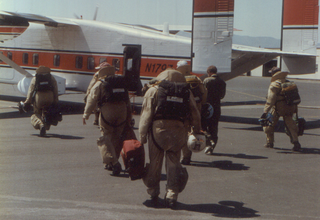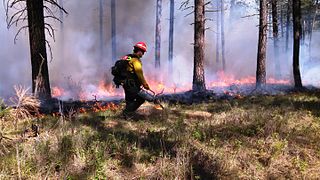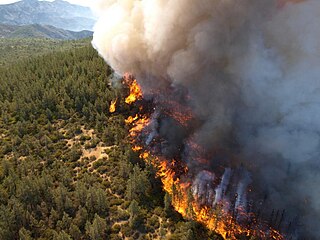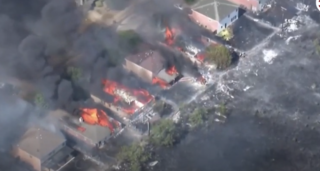Northern hemisphere
- Wildfires in the United States during 2024
- 2024 Texas wildfires
- Smokehouse Creek Fire, the largest in Texas history
- 2024 Texas wildfires
- 2024 Canada wildfires
| Wildfires in 2024 | |
|---|---|
| Date(s) | January–May 2024 |
| Season | |
← 2023 | |
Wildfires in 2024 include:

Smokejumpers are specially trained wildland firefighters who provide an initial attack response on remote wildfires. They are inserted at the site of the fire by parachute. This allows firefighters to access remote fires in their early stages without needing to hike long distances carrying equipment and supplies. Traditional terrestrial crews can use only what they can carry and often require hours and days to reach fire on foot. The benefits of smokejumping include the speed at which firefighters can reach a burn site, the broad range of fires a single crew can reach by aircraft, and the larger equipment payloads that can be delivered to a fire compared to pedestrian crews.

Smokey Bear is an American campaign and advertising icon of the U.S. Forest Service in the Wildfire Prevention Campaign, which is the longest-running public service announcement campaign in United States history. The Ad Council, the United States Forest Service (USFS), and the National Association of State Foresters (NASF), in partnership with creative agency FCB, employ Smokey Bear to educate the public about the dangers of unplanned human-caused wildfires.

A controlled or prescribed (Rx) burn is the practice of intentionally setting a fire to change the assemblage of vegetation and decaying material in a landscape. The purpose could be for forest management, ecological restoration, land clearing or wildfire fuel management. A controlled burn may also refer to the intentional burning of slash and fuels through burn piles. Controlled burns may also be referred to as hazard reduction burning, backfire, swailing or a burn-off. In industrialized countries, controlled burning regulations and permits are usually overseen by fire control authorities.

Possum Kingdom State Park is a state park in Palo Pinto County, Texas, USA, that was built in the 1940s by Civilian Conservation Corps Company 2888 and opened to the public in 1950. It covers approximately 1,530 acres (620 ha), and lies in the Palo Pinto Mountains and Brazos River Valley of Texas. The park borders the large Possum Kingdom Lake, a 20,000-acre (8,100 ha) lake known for its clear blue waters. Possum Kingdom winds for 65 miles (105 km) down the Brazos River, and has more than 300 miles (480 km) of shoreline. A privately owned store and marina in the park cater to boaters and campers.
The Claremont Canyon Conservancy, a California nonprofit corporation, provides stewardship, advocacy, and educational programs for its members and the public regarding Claremont Canyon, a 500-acre (2.0 km2) wildland canyon in the East Bay Hills. The conservancy owns no land but works cooperatively with the canyon’s multiple landowners, including the East Bay Regional Park District, the University of California, Berkeley, the East Bay Municipal Utility District, the City of Berkeley, and the City of Oakland.

The 2011 Texas wildfires were a series of destructive wildfires in Texas that occurred in the 2011 fire season. During 2011 in Texas, around 31,453 fires had burned 4,000,000 acres or 16,190 square kilometres, 2,947 homes, and over 2,700 other structures. 47.3% of all acreage burned in the United States in 2011 was burned in Texas. The fires had been particularly severe due to the 2011 Southern US drought that covered the state, and was exacerbated by the unusual convergence of strong winds, unseasonably warm temperatures, and low humidity.

The 2010–2013 Southern United States and Mexico drought was a severe to extreme drought that plagued the Southern United States, including parts of Texas, Louisiana, Arkansas, Mississippi, Alabama, Georgia, South Carolina, North Carolina, Florida, and Oklahoma; the Southwestern States, including Kansas, Colorado, New Mexico, and Arizona; as well as large parts of Mexico, in a three-year pattern from 2010 to 2013.

The Bastrop County Complex fire was a conflagration that engulfed parts of Bastrop County, Texas, in September and October 2011. The wildfire was the costliest and most destructive wildfire in Texas history and among the costliest in U.S. history, destroying 1,696 structures and causing an estimated $350 million in insured property damage. An exceptional drought, accompanied by record-high temperatures, affected Texas for much of 2011. Vegetation consequently became severely parched throughout the state, and over the year an unprecedented amount of land in the state was burned by numerous wildfires. In early September 2011, the presence of Tropical Storm Lee to the east produced strong northerly winds over the state, exacerbating the preexisting dry weather to produce critical fire conditions. On the afternoon of September 4, 2011, three separate fires ignited in the wildland–urban interface east of Bastrop, Texas, after strong winds caused by the nearby tropical storm snapped trees onto power lines. Within 48 hours, the fires merged into one blaze that quickly consumed parts of Bastrop State Park and parts of the Lost Pines Forest, as well as homes in nearby subdivisions. Most of the conflagration's spread and destruction occurred within a week of ignition, as the forward advance of the wildfire mostly stopped after September 7. The wildfire was largely contained in September, though the firebreak was briefly breached in early October. On October 10, the Bastrop County Complex was declared controlled, and the fire was declared extinguished on October 29 after 55 days of burning within the fire perimeter.

The Happy Camp Complex Fire was a massive wildfire that broke out on August 12, 2014, at 1:00 AM PDT, as a result of a lightning strikes in the Klamath National Forest in Northern California. The fire, which would eventually consume 134,056 acres (543 km2) of land, was the largest fire of the 2014 California wildfire season and as of 2018, ranks 20th on the list of largest fires in state history.

The Butte Fire was a rapidly moving wildfire during the 2015 California wildfire season that started on September 9 in Amador County, California. The fire burned 70,868 acres (287 km2).

The Erskine Fire was a wildfire in the Lake Isabella area of Kern County. It was the second-largest wildfire of the 2016 California wildfire season. It was also the first fire of the year to have fatalities and is the 15th most destructive fire in state history.

A megafire is an exceptional fire that devastates a large area. They are characterised by their intensity, size, duration and uncontrollable scale. There is no precise scientific definition.

The 2021 Texas wildfires were a series of wildfires in Texas in 2021.
The 2021 wildfire season involves wildfires on multiple continents. Even at halfway through the calendar year, wildfire seasons were larger than in previous history, with increased extreme weather caused by climate change strengthening the intensity and scale of fires.

The 2022 Texas Wildfires are a series of wildfires occurring in 2022 in the state of Texas. They include 371 individual fires occurring throughout Texas. A total of 210,045 acres were burned in the 2022 Texas wildfires according to the Texas A&M Forest Service, with the largest fire being the Eastland Complex fire.

The Smokehouse Creek Fire was a record-breaking wildfire affecting the northeastern Texas panhandle and western Oklahoma that started on February 26, 2024. The fire affected numerous communities in Hemphill and Roberts counties, including the town of Canadian. As of March 16, 2024, the fire had burned approximately 1,058,482 acres before it was successfully contained, making it the largest wildfire on record in Texas's history as well as the largest wildfire in the United States during 2024. It was one of multiple fires during an outbreak of wind-driven wildfires in the Great Plains.
The 2024 Texas wildfires were marked by several major fires, including the Smokehouse Creek Fire in the Texas panhandle and part of Oklahoma.